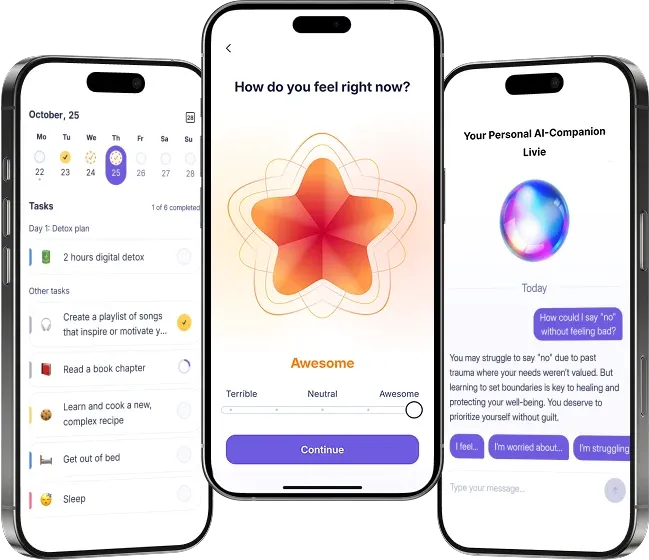The Dopamine Reward System: How Addiction Hijacks Your Brain’s Chemistry

Imagine you’re about to get home and take the first bite of your favorite dessert you’ve been thinking about today. Before your fork even touches the plate, your brain lights up in anticipation. That’s dopamine at work. It doesn’t just make you feel good — it helps your brain recognize and seek out things that bring pleasure or are essential for survival, like eating, bonding with others, or achieving goals.
When we learn that a particular action leads to a positive outcome, dopamine helps strengthen the connection between the action and reward, which motivates us to repeat that behavior in the future. This makes us more likely to repeat the behavior.
This same mechanism is what makes dopamine so integral to addiction. Studies show that addictive substances and behaviors may, figuratively speaking, hijack the brain's reward system by creating surges of dopamine that reinforce bad habits (Wise and Jordan, 2021). Over time, this repeated stimulation can alter brain chemistry and make natural rewards, like social interactions or hobbies, less interesting.
If you’ve ever wondered why some habits feel so impossible to break, dopamine is a part of the answer. It’s important to understand that dopamine is not the only driver behind addiction. However, there are many misconceptions surrounding the issue, so today, we want to clarify how this neurotransmitter actually affects our brains and what role it plays in developing addictions.
The Dopamine Reward System
Dopamine plays a crucial role in our everyday experiences of pleasure and motivation. When you do something enjoyable, like eating your favorite meal or laughing with friends, your brain’s reward center releases dopamine. This release reinforces the connection between the action and the reward, making us more likely to repeat the behavior.
Dopamine neurons fire in short bursts (phasic firing) when we experience a reward (Hazy et al., 2010). Phasic activity arises from unexpected or unpredictable rewards, whereas anticipated rewards may not trigger such activity. This phasic activation stamps in long-term memories that connect specific cues with the reward, which helps create powerful associations.
When the human brain experiences something pleasurable, it releases a burst of dopamine in specific regions, including the striatum. For instance, eating chocolate or listening to music you love activates this system, giving you that "feel-good" sensation.
But this surge isn’t just about pleasure — it’s about learning. Dopamine enhances synaptic plasticity and strengthens the connection between stimulus and reward through its interaction with other molecular mechanisms, such as NMDA receptors. This connects specific actions (like eating or laughing) with positive feelings. These associations encourage repetition, and that’s what keeps us motivated to seek out similar experiences.
According to Wise (2004), the motivational effectiveness of reward-associated stimuli does not necessarily involve immediate dopamine function. However, phasic dopamine increases can further amplify the effectiveness of the stimulus.
Over time, repeated exposure to certain rewards causes dopamine receptors in the brain to downregulate or, simply put — literally decrease their availability. This phenomenon is called tolerance and involves a decrease in receptor sensitivity, not just their quantity. This change, commonly observed in addiction, diminishes interest in activities that don’t involve the reward.
How Addiction Alters Dopamine Pathways
Addiction fundamentally disrupts the brain’s natural reward system. If triggered by an addictive substance or a habit like gambling, it overstimulates the dopamine reward system (Devoto et al., 2016). This can lead to long-term changes in the brain's structure and function.
Addictive drugs like cocaine, nicotine, and opioids flood the brain with unnaturally high levels of dopamine (Sayın, 2019). However, not all drugs directly increase dopamine levels. For example, alcohol and cannabis have an indirect effect through other neurotransmitter systems, which also stimulate dopamine.
This “high” is much more intense than what natural rewards produce. Over time, the brain adapts to this overstimulation by reducing the number of active dopamine receptors. This downregulation decreases sensitivity to dopamine, which may lead to a state called anhedonia — the inability to feel pleasure from everyday activities.
Repeated exposure strengthens the connection between the substance and environmental cues (like seeing a bar or certain friends). This makes our cravings nearly automatic when triggered.
In a non-addicted brain, dopamine provides balanced motivation for both short-term rewards (eating) and long-term goals (career achievements). However, in addiction, the dopamine reward system becomes hyper-focused on the substance or behavior, sidelining other priorities. Here are some of the key ways addiction can influence our brains and behavior:
- Addictive behaviors form because dopamine "stamps in" certain actions as highly rewarding. This makes the brain prioritize them, even when they lead to negative consequences like health issues or strained relationships.
- For people with mental health issues, drug addiction may be especially dangerous. Some people may resort to substance use, trying to alleviate anxiety or depression symptoms. However, substance use disorder may worsen the symptoms over time as it alters brain function and can contribute to the development of other mental issues.
- Addiction rewires the brain to prefer immediate gratification over delayed benefits. Here's how it works: addiction increases activity in the reward system while weakening cognitive control, which makes impulsive decisions more likely. Impulsive choices and compulsive behaviors, even if dangerous, will be pursued, and more important matters may be abandoned.
- Physical health also suffers. Certain addictions greatly contribute to the development of cardiovascular diseases, cancer, lung disease, stroke, and increased risk of HIV/AIDS.
The result is a vicious cycle: the more the addiction is fed, the more the brain becomes dependent on the addictive stimulus, and the harder it becomes to find pleasure elsewhere.
Reasons behind addiction may vary, but regardless of the cause — don’t be afraid to seek help. Talk to someone you trust or reach out to your healthcare provider.
Types of Addictions That Impact Dopamine
There are multiple categories of addictions, but most of them could be divided into two broad categories: substance use disorders and behavioral addictions. Both can affect the dopamine reward system, but their mechanisms and triggers differ.
Substance Use Disorders
These involve drug abuse, where the brain is flooded with dopamine from substances like alcohol, nicotine, and opioids. Drugs bypass natural dopamine release processes, which creates unnaturally high spikes. However, not all drugs work the same way. For example, alcohol operates through indirect mechanisms rather than exclusively through dopamine pathways. Cocaine, for instance, prevents dopamine from being reabsorbed, prolonging its effects, while opioids trigger excessive dopamine bursts by binding to specific receptors (Wise and Jordan, 2021).
Over time, the brain adapts by reducing its ability to naturally produce and respond to dopamine. This makes many people reliant on the drug to feel normal.
Behavioral Addictions
These are compulsive behaviors that mimic the effects of substances on the brain. Examples include:
- Gambling addiction: Wins and near-misses trigger phasic dopamine bursts, reinforcing risky behavior (Moore et al., 2014).
- Digital addiction: Social media and gaming apps are designed to exploit reward pathways by offering intermittent dopamine rewards through likes, notifications, or achievements (Aagaard, 2021). These interval reinforcement in digital applications is based on mechanisms similar to gambling, which strengthens the connection between trigger and response.
- Food addiction: High-calorie foods stimulate dopamine in a way similar to drugs, leading to overconsumption and decreased sensitivity to natural rewards (Volkow et al., 2017).
Activities like exercise or spending time with loved ones produce moderate, balanced dopamine release. These rewards promote well-being without overwhelming the system.
It might not be easy to just stop indulging in an unhealthy behavior to stop the cycle of addiction. While the public generally recognizes the dangers of “established” addictions, issues like food or digital addiction are only being explored in-depth now. As the internet has developed very rapidly, many have noticed the addictive nature of unlimited access to content and entertainment.
Practices like “dopamine fasting” and other practices have been introduced in the past couple of years to offer a relatively easy way out. “Dopamine fast,” for example, was created by Dr. Cameron Sepah, a California psychiatrist, in 2019. The method is rooted in cognitive behavioral therapy and is meant to help us become less dependent on social media and instant gratification. However, the method was largely misinterpreted by the public.
You see, dopamine is a neurotransmitter, one of those involved in the formation of addiction. All addictions share a common mechanism, including hyperactivity of the reward system and reduced prefrontal cortex function, though different types of addictions may vary in their triggers and behavioral manifestations.
This means it cannot be approached like cocaine or alcohol, and just a “tolerance break” will not do the trick. “Fasting” should be seen as a way to gradually move to more naturally rewarding and mindful activities. However, many people are taking a much more radical approach to managing their dopamine addiction. Many dopamine fasters actually deprive themselves of healthy activities because of scientific misinterpretation or just hopping on a trend.
If you’re struggling with unhealthy behaviors or substance abuse, try to talk it through with a licensed medical professional. Many tips you see on the internet might sound like they make sense or be totally logical, but the reality is usually more complicated. We all want a simple solution, but your health and well-being should be a priority.
Understanding and Managing Addictive Behaviors
Breaking free from addictive behaviors is a complex issue and takes more than just willpower. It’s important to understand that the problem involves the brain’s altered chemistry, disrupted habits, and underlying emotional and psychological factors. Addiction reinforces pathological behavior patterns through dopamine signals, which create strong connections between triggers and rewards.
Successful recovery requires a combination of evidence-based strategies, social support, and the cultivation of healthier habits that rebuild the dopamine reward system naturally. Naturally, the rebuilding can take months or even years, depending on the addiction and neuroplasticity levels. These are some things you can try.
Rewire Habits
Our brains thrive on patterns, and addiction reinforces unhealthy ones by repeatedly activating the dopamine reward system. To deal with this, you can:
- Exercise more. This boosts dopamine release naturally and improves mood.
- Explore creative hobbies such as painting, music, or journaling to stimulate pleasure and reduce stress.
- Practice mindfulness or meditation. It calms the mind and helps regulate cravings by reducing emotional reactivity. Regular practice also promotes connections between the prefrontal cortex and the reward system, which, in turn, improves our self-control.
Delay Gratification
You can train your brain to accept delayed rewards, which is crucial for dopamine balance recovery. Over time, this practice can lead to long-term changes in the brain's neuroplasticity, such as strengthening neural pathways associated with self-control, patience, and emotional regulation.
Start small. Break big goals into small steps to experience progress and celebrate small wins. You can gradually increase the complexity of the tasks over time. It can help you avoid being overwhelmed and overly stressed. This can bring you satisfaction without excessive pressure.
Your next step could be using techniques like “temptation bundling,” where a desired activity is paired with a less appealing task to increase motivation. Practicing mindful decision-making to pause and reflect before acting impulsively will help you promote self-control and gradually reduce impulsivity, which is a part of addiction.
Challenge Thought Patterns
Addiction often involves deeply ingrained beliefs and automatic thoughts that justify the behavior. Cognitive-behavioral therapy can be particularly effective in identifying and reworking these thought patterns.
- Learn to recognize triggers, such as stress or boredom, and develop healthier coping mechanisms.
- Use CBT techniques like reframing to challenge distorted beliefs (e.g., “I can’t cope without this substance”).
- Practice self-compassion to reduce guilt and shame. You’re not perfect. And nobody is. It’s okay if you make mistakes along the way. Beating yourself for taking a step back won’t help. If anything, it can trigger a relapse.
Sustainable progress requires support. Professional therapy can provide a safe space to explore the root causes of addiction and develop personalized strategies for recovery. CBT, in particular, helps manage triggers and replace addictive habits with healthier ones (Bador and Kerekes, 2020).
Individual or group counseling can also be beneficial in managing addiction. You can get a personalized recovery plan and explore the underlying issues behind your addiction. In a group setting, sharing stories and experiences can be very rewarding and decrease feelings of loneliness and isolation.
Dialectical behavioral therapy is another effective therapy approach that can be helpful in case of addiction (Rezaie et al., 2021). This type of therapy promotes behavioral skill development and is heavily focused on mindfulness, distress tolerance, interpersonal effectiveness, and emotion regulation.
You can also connect with other people struggling with the same issue. It can be a helpful and empowering experience for people struggling with addictions. You might have heard about AA — Alcoholics Anonymous — but there are way more resources that help connect people with various issues. Here are some of the resources you might find beneficial:
- Addiction Education Society
- Alcoholics Anonymous
- SMART Recovery
- Narcotics Anonymous
- SOS (Secular Organizations for Sobriety)
- Celebrate Recovery (Christian-based support group)
- Adult Children of Alcoholics
- Families Anonymous
Conclusion: Restoring Balance in the Reward System
Addictions don’t define us — it’s a condition deeply tied to the dopamine reward system in our brain, which has been disrupted by repeated cycles of addictive behavior. Understanding this is key..
You can help yourself by engaging in activities that naturally stimulate dopamine, such as regular exercise, creative hobbies, and mindfulness practices. Therapy and support groups provide you with tools for managing cravings, reframing negative thought patterns, and addressing emotional triggers. Over time, these strategies can help you restore and maintain balance, strengthen resilience, and promote long-term recovery.
If you’re struggling, know that help is available, and seeking support is a courageous step. Progress takes time, but every small effort is a victory. You have the power to rebuild, reclaim balance, and find genuine happiness beyond addiction. You are not alone.
References
Bador, K., & Kerekes, N. (2020). Evaluation of an integrated intensive cognitive behavioral therapy treatment within addiction care. The Journal of Behavioral Health Services & Research, 47(1), 102–112.
Devoto, P., Fattore, L., Antinori, S., Saba, P., Frau, R., Fratta, W., & Gessa, G. L. (2016). Elevated dopamine in the medial prefrontal cortex suppresses cocaine seeking via D1 receptor overstimulation. Addiction Biology, 21(1), 61–71.
Hazy, T. E., Frank, M. J., & O’Reilly, R. C. (2010). Neural mechanisms of acquired phasic dopamine responses in learning. Neuroscience & Biobehavioral Reviews, 34(5), 701–720.
Moore, T. J., Glenmullen, J., & Mattison, D. R. (2014). Reports of pathological gambling, hypersexuality, and compulsive shopping associated with dopamine receptor agonist drugs. JAMA Internal Medicine, 174(12), 1930–1933.
Rezaie, Z., Afshari, B., & Balagabri, Z. (2021). Effects of dialectical behavior therapy on emotion regulation, distress tolerance, craving, and depression in patients with opioid dependence disorder. Journal of Contemporary Psychotherapy, 1–10.
Sayın, Ü. (2019). A schematic overview of addiction: Molecular effects of cocaine, methamphetamine and morphine on limbic neurons. Forensic Science Addictive Research, 4(4), 1–11.
Wise, R. A. (2004). Dopamine, learning, and motivation. Nature Reviews Neuroscience, 5(6), 483–494.
Wise, R. A., & Jordan, C. J. (2021). Dopamine, behavior, and addiction. Journal of Biomedical Science, 28(1), 83.

